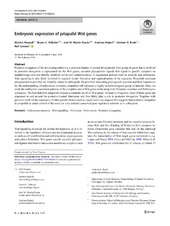| dc.contributor.author | Hogvall, Mattias | |
| dc.contributor.author | Vellutini, Bruno Cossermelli | |
| dc.contributor.author | Martin-Duran, José M. | |
| dc.contributor.author | Hejnol, Andreas | |
| dc.contributor.author | Budd, Graham E. | |
| dc.contributor.author | Janssen, Ralf | |
| dc.date.accessioned | 2019-08-23T09:19:56Z | |
| dc.date.available | 2019-08-23T09:19:56Z | |
| dc.date.issued | 2019-07 | |
| dc.Published | Hogvall, Vellutini BC, Martin-Duran JM, Hejnol A, Budd GE, Janssen R. Embryonic expression of priapulid Wnt genes. Development, Genes and Evolution. 2019;229(4):125–135 | eng |
| dc.identifier.issn | 0949-944X | |
| dc.identifier.issn | 1432-041X | |
| dc.identifier.uri | https://hdl.handle.net/1956/20716 | |
| dc.description.abstract | Posterior elongation of the developing embryo is a common feature of animal development. One group of genes that is involved in posterior elongation is represented by the Wnt genes, secreted glycoprotein ligands that signal to specific receptors on neighbouring cells and thereby establish cell-to-cell communication. In segmented animals such as annelids and arthropods, Wnt signalling is also likely involved in segment border formation and regionalisation of the segments. Priapulids represent unsegmented worms that are distantly related to arthropods. Despite their interesting phylogenetic position and their importance for the understanding of ecdysozoan evolution, priapulids still represent a highly underinvestigated group of animals. Here, we study the embryonic expression patterns of the complete sets of Wnt genes in the priapulids Priapulus caudatus and Halicryptus spinulosus. We find that both priapulids possess a complete set of 12 Wnt genes. At least in Priapulus, most of these genes are expressed in and around the posterior-located blastopore and thus likely play a role in posterior elongation. Together with previous work on the expression of other genetic factors such as caudal and even-skipped, this suggests that posterior elongation in priapulids is under control of the same (or very similar) conserved gene regulatory network as in arthropods. | en_US |
| dc.language.iso | eng | eng |
| dc.publisher | Springer | eng |
| dc.rights | Attribution CC BY | eng |
| dc.rights.uri | http://creativecommons.org/licenses/by/4.0 | eng |
| dc.subject | Ecdysozoan ancestor | eng |
| dc.subject | Wnt signalling | eng |
| dc.subject | Evolution | eng |
| dc.subject | Penis worm | eng |
| dc.subject | Posterior elongation | eng |
| dc.title | Embryonic expression of priapulid Wnt genes | eng |
| dc.type | Journal article | eng |
| dc.type | Peer reviewed | eng |
| dc.date.updated | 2019-07-05T08:02:56Z | |
| dc.description.version | publishedVersion | |
| dc.rights.holder | Copyright 2019 The Author(s) | eng |
| dc.identifier.doi | https://doi.org/10.1007/s00427-019-00636-6 | |
| dc.identifier.cristin | 1710254 | |
| dc.source.journal | Development, Genes and Evolution | |

